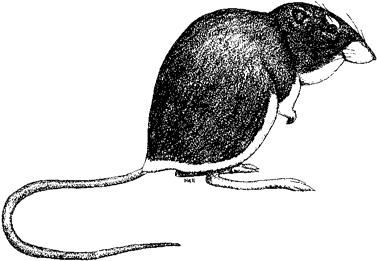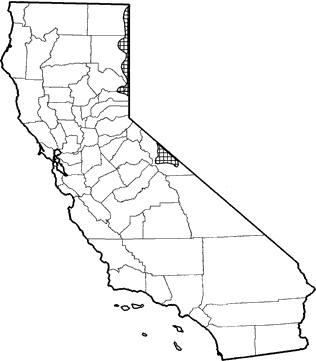
Dark Kangaroo Mouse
Distribution, Abundance, and Seasonality
In California, found in a narrow corridor in northeastern California from eastern Modoc Co. south to eastern Sierra Co., and in central to east-central Mono Co. Abundant in sagebrush and alkali desert scrub habitats; common to uncommon in bitterbrush and low sage habitats.

Range Map
Specific Habitat Requirements
Feeding: Mainly granivorous, but also eats some insects and carrion (Hall 1946). Eats seeds and green vegetation of desert plants, including blazing star, wild buckwheat, lupine, and desert plantain (Ingles 1947). Laboratory animals maintain large caches in their burrows.
Cover: Burrows usually are constructed in fine, gravelly soils, but sometimes in sand dunes as well (O'Farrell and Blaustein 1974). Ingles (1965) indicated it preferred sandy soils among sagebrush.
Reproduction: Young are born in nest chambers in underground burrows. Nests are built of dry plant parts. Tunnels tend to be from 1.2-1.8 m (4-6 ft) long, unbranched, and approximately 0.3 m (1 ft) from the surface. They usually are closed during the day, making them difficult to locate (Ingles 1965).
Water: Does not drink water, but captive individuals eat leafy vegetation.
Pattern: Prefers sandy to gravelly soils with some shrub cover.
Species Life History
Activity Patterns: Nocturnal. Most activity has been recorded in first 2 hr after sunset, and is sporadic for the rest of the night. Reduced activity during moonlight and during high winds (O'Farrell 1973). Probably hibernates in cold weather, though individuals have been caught above ground when snow was present.
Seasonal Movements / Migration: None.
Home Range: In Nevada, mean annual home range of males was 0.7 ha (1.7 ac) and 0.4 ha (1 ac) for females (O'Farrell 1973).
Territory: Aggressively solitary. No data on territory size available.
Reproduction: Breeds from March to July. Average litter size 3.9 young (range 2-7) (Hall 1946).
Niche: The dark kangaroo mouse is a specialized granivore. The hind feet are adapted for bipedal movement on fine sand (Bartholomew and Cary 1954). The auditory bullae are extremely inflated, presumably increasing auditory sensitivity (for predator escape). Potential competitors include other heteromyid rodents, especially Perognathus longimembris, P. parvus, and Dipodomys ordii. Predators include snakes, owls, and predatory mammals.
Sources & References
California Department of Fish and Game, 1999.
California's Wildlife, Sacramento, CA.
Written by: P. Brylski, reviewed by: H. Shellhammer, edited by: R. Duke
Bartholomew, G. A., and G. R. Cary. 1954. Locomotion in pocket mice. J. Mammal. 35:386-392. Ghiselin, J. 1970. Edaphic control of habitat selection by kangaroo mice (Microdipodops) in three Nevada populations. Oecologia (Berlin) 4:248-261. Hall, E. R. 1946. Mammals of Nevada. Univ. California Press, Berkeley. 710pp. Hall, E. R., and J. M. Linsdale. 1929. Notes on the life history of the kangaroo mouse (Microdipodops). J. Mammal. 10:298-305. Ingles, L. G. 1947. Ecology and life history of the California gray squirrel. Calif. Fish and Game 33:138-158. Ingles, L. G. 1965. Mammals of the Pacific states. Stanford Univ. Press, Stanford, CA. 506pp. O'Farrell, M. J. 1973. Seasonal activity patterns, population dynamics, and spatial relationships of rodents in a sagebrush community. Ph.D. Thesis, Univ. Nevada, Reno. 168pp. O'Farrell, M. J., and A. R. Blaustein. 1974. Microdipodops megacephalus. Mammal. Species No. 46. 3pp.
California Animal Facts | California's Wildlife